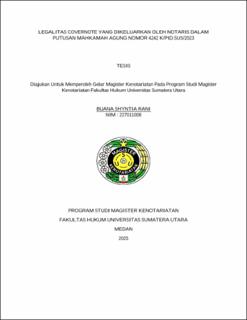| dc.description.abstract | In banking practice, it is not uncommon for bank officials to become involved
in criminal acts of corruption related to non-performing loans (bad credit) granted to
debtors. This often relates to covernotes issued by notaries to banks. In fact, a
covernote merely serves as an administrative document in the form of a statement letter
explaining the notary's ongoing work, such as the preparation of authentic deeds and
documents. The issuance of a covernote by a notary to a bank is purely administrative
and internal in nature, and the notary should not be held responsible for any default
committed by the debtor in relation to the credit facility provided by the bank.
This research employs a normative legal research method with an emphasis on
statutory approaches. The data consist of primary, secondary, and tertiary legal
materials, collected through literature study and analyzed using a qualitative
normative data analysis method.
The research findings indicate that covernotes do not fall under the formal
authority of notaries, but rather arise from customary practices as supplementary
documents supporting the process of authentic deed issuance. The relationship between
banks and notaries is strictly internal and administrative; however, in certain cases,
notaries may still be held criminally liable for corruption in connection with issuing
covernotes in credit facilities. Additionally, notaries may also face administrative
sanctions for maladministration. Therefore, it is recommended that the legal status of
covernotes be formally regulated under statutory law, and that notaries exercise
greater caution in issuing covernotes, especially when signing credit agreements.
Clear boundaries must be established regarding the issuance of covernotes to ensure
legal protection and deterrence for all parties involved. | en_US |


